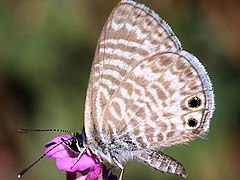
The common blue butterfly or European common blue is a butterfly in the family Lycaenidae and subfamily Polyommatinae. The butterfly is found throughout the Palearctic and has been introduced to North America. Butterflies in the Polyommatinae are collectively called blues, from the coloring of the wings. Common blue males usually have wings that are blue above with a black-brown border and a white fringe. The females are usually brown above with a blue dusting and orange spots.

Lycaenidae is the second-largest family of butterflies, with over 6,000 species worldwide, whose members are also called gossamer-winged butterflies. They constitute about 30% of the known butterfly species.

Leptotes is a butterfly genus in the family Lycaenidae. They are commonly known as zebra blues in reference to their zebra-striped undersides.

Leptotes pirithous, commonly known as Lang's short-tailed blue or common zebra blue, is a butterfly of the family Lycaenidae.

Philotes is a genus of butterflies in the family Lycaenidae. Philotes is a monotypic genus containing only Philotes sonorensis, the Sonoran blue or stonecrop blue, found in North America in California and Baja California. The habitat consists of rocky washes, outcrops and cliffs in deserts.

Leptotes babaulti, also known as the Babault's zebra blue, is a butterfly of the family Lycaenidae. This species has 2 discovered and accepted subspecies which are leptotes babulti juncta and leptotes babaulti ornata.

Leptotes cassius, the Cassius blue or tropical striped blue, is a butterfly of the family Lycaenidae. It is found in North America in Florida including the Keys, Texas south through the Caribbean, Mexico, and Central America to South America. Strays have been found in New Mexico, Kansas, Missouri, South Carolina, North Carolina and Virginia.

Leptotes brevidentatus, the short-toothed blue or Tite's zebra blue, is a butterfly of the family Lycaenidae. It is found in Africa south of the Sahara and south-western Arabia.
Leptotes jeanneli, the Jeannel's blue, is a butterfly of the family Lycaenidae.
Leptotes pulcher, the beautiful zebra blue, is a butterfly of the family Lycaenidae. It is found in Africa south of the Sahara.

Euphyes vestris, the dun skipper, sedge witch or dun sedge skipper, is a species of butterfly of the family Hesperiidae. It is found in North America from Nova Scotia west across southern Canada to southern Alberta, south to Florida, the Gulf Coast and eastern Texas. There are disjunct populations in the High Plains and Rocky Mountains and along the Pacific Coast.

Echinargus isola, or Reakirt's blue, is a butterfly of the family Lycaenidae. It is the sole representative of the monotypic genus Echinargus. It is found in Central America and the extreme southern U.S. Echinargus isola migrates regularly throughout most of the U.S. almost to the Canada–United States border, and very rarely into the southern prairies.
Leptotes adamsoni, the Adamson's zebra blue, is a butterfly in the family Lycaenidae. It is found in Kenya. The habitat consists of riverine vegetation with Cordia sinensis as the dominant plant.
Leptotes marginalis, the black-bordered zebra blue, is a butterfly in the family Lycaenidae. It is found in Sudan, Uganda, Kenya, the Democratic Republic of the Congo, Rwanda, Burundi, Tanzania and Zambia.
Leptotes mandersi is a butterfly in the family Lycaenidae first described by Hamilton Herbert Druce in 1907. It is endemic to Mauritius. The habitat consists of coastal areas.

Leptotes webbianus, the Canary blue, is a butterfly in the family Lycaenidae. It is endemic to the Canary Islands.
Leptotes sanctithomae is a butterfly in the family Lycaenidae. It is found on São Tomé Island. The type locality is the settlement of São Nicolau, Mé-Zóchi District. It was described by Emily Mary Bowdler Sharpe in 1893.
Iridana marina is a butterfly in the family Lycaenidae. It is found in Uganda, the north-eastern part of the Democratic Republic of the Congo and north-western Tanzania. The habitat consists of forests.

Hemiargus ceraunus, the Ceraunus blue, is a species of butterfly in the family Lycaenidae. The species was first described by Johan Christian Fabricius in 1793. It is found in the southwestern United States, southern Texas, Florida and the Florida Keys south through the West Indies, Mexico and Central America to South America. Strays may be found in North Carolina, Missouri, Kansas and Nevada. The habitat consists of open woodland, desert scrub, dunes, pastures, road edges and vacant lots.














